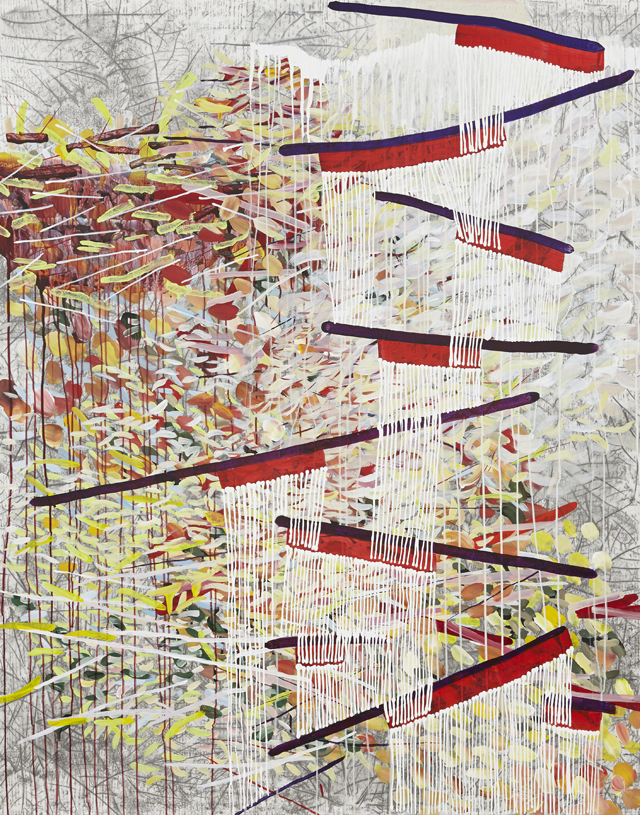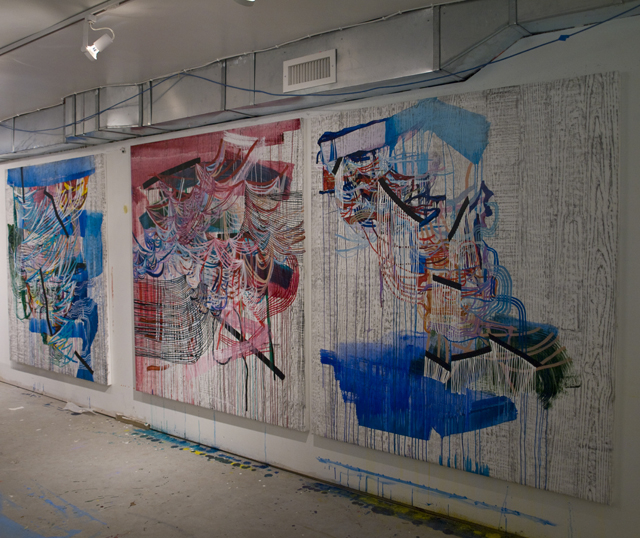
Pining, Graphite, fluid acrylic and ink on yupo, 60”x48”, 2014 Photo courtesy of Rick Wester Fine Art
Briefly describe the work you do.
All of my paintings begin on a lustrous bright white sheet of yupo with graphite rubbing of wood grain from the pressure treated decking behind my kitchen. Both the wood and paper are man made: improved upon. This simultaneously toxic and natural impression is captured on synthetic Japanese paper made of polypropylene—which ironically, is a “green” material. On top of this I create layered biomorphic abstractions composed of accumulated mark making and large areas of transparent and painterly color. I incorporate my surroundings, personal experience and environmental concerns into the work, including the pervasive infiltration of chemicals into our daily lives, by combining organic forms, stringy and obsessive lines, pipes, bony protrusions, then viscous pours, slip trailing of paint and direct graphite rubbings of wood grain. My vocabulary has evolved out of the visual residue of making photographs, prints, ceramic objects and drawings as well as the continuous reprocessing my own paintings as source material. Scale and variation contribute to the evolution and create a structure for decision making. I document the work at regular intervals using an iphone and rework and reenvision the photos using drawing apps. These pictures trace the evolution of the layers of imagery within each painting and also serve as source material as a body of work unfolds.
Tell us about your background and how that has had an influence on your work and on you as an artist.
My mother is an intrinsically creative person- not an exhibiting artist but a chronic creator. I grew up immersed in this: our suburban home doubled as her studio and overflowed with the artifacts of her artistic development: almost closed bulbous ceramic forms from her college classes taught by Tashiko Takaezu, torn rough clay sculptures she constructed in the vein of Peter Voulkos, big abstract expressionist figure paintings, then portraiture and still life painting inspired by Alice Neel, Jack Beal and Janet Fish. Later tall stacks of narrative ballpoint pen drawings piled up created on shirt cardboards from the dry cleaner drafted using pens from the Marriott where my father earned points on business trips. Burly itchy weavings covered wicker chairs and an eclectic sensibility pervaded. Later Diane Arbus books and Lucas Samaras imagery entered the conversation as she began class work in photography. I took all of this for granted and absorbed the oddity as an everyday occurrence but under the surface my sensibility was gelling. The objects I was surrounded by were both commonplace and illegible to me: closed forms that were ceramic “pots”, torn scratched slabs of clay that were vessel and sculpture on a coffee table, oddly composed paintings and palettes that were sweet, garish, tasteful and distasteful at once. It was all filtering in. Ultimately, my paintings never resembled my mother’s work in terms of style but perhaps we share other inclinations that led me to make work that is intuitive and materials driven. I learned to seek and recognize the qualities of various materials, question them, experiment, find the unexpected and the obvious- and to value fluency among various media and modes of expression.
The concept of the artist studio has a broad range of meanings in contemporary practice. Artists may spend much of their time in the actual studio, or they may spend very little time in it. Tell us about your individual studio practice and how it differs from or is the same as traditional notions of “being in the studio.”
I have a pretty consistent studio practice- and it’s not that mysterious. My studio is in my home and I value the flexibility of coming and going at any time of the day or night to take a look. I usually work in 3 hour blocks of time and try to work or spend time looking everyday.
What roles do you find yourself playing that you may not have envisioned yourself in when you first started making art?
As many other artists have mentioned, I did not realize how much time and effort I would expend doing research, corresponding, writing proposals and advocating for myself.
Although it seems obvious now, I did not envision how intertwined my studio practice and every day life as a mother and wife would be. When I finished graduate school I married my longtime boyfriend who happened to be a college football coach. Although football and painting are worlds apart, they are both very consuming and there are always a lot of unknowns. That worked for us and I assumed my life would be this unique combination of studio and stadium. My husband died of cancer at 43 and so now I am a single mother of teenagers which is certainly not a role I ever imagined. Having my studio at home makes it easier to juggle and join the two worlds I’m living in. When they agree, I bring my kids along to galleries, museums and openings and I love hearing their insights- and on occasion they come into the studio and make things while I am working.
When do you find is the best time to make art? Do you set aside a specific time everyday or do you have to work whenever time allows?
Typically, the morning is the best time for me and I definitely schedule the first half of the day as studio time.

Sway (purple), Graphite, fluid acrylic and ink on yupo, 60”x48”, 2015 Photo courtesy of Rick Wester Fine Art
How has your work changed in the past five years? How is it the same?
In the past five years I transitioned from working monochromatically to using a very broad palette and from exploring a compact composition – almost an organism – to a world that spreads out to every edge. The work continues to be constructed in layers and evolves over a long period of time and many sessions in the studio.
How have people such as family, friends, writers, philosophers, other artists or even pop icons had an impact on the work you do?
A few qualities I admire in other artist’s work and strive for in my own include directness, oddity, beauty and discomfort as well a sense of immediacy. Artists whose work I love include Mark Bradford, Philip Guston, Nick Cave, David Altmejd, Ben Degen, Katherine Bradford, Rebecca Morales, Jennifer Reeves, Eva Hesse, Louise Bourgeoise, Barnaby Furnas… of course Giotto. Japanese screen painting, Indian miniatures and Manuscript illuminations are equally compelling. Most recently I saw work by Ruth Root and Paul Wackers that was fantastic.
Have you ever been pulled in the direction of a pursuit other than being an artist? What are your other interests?
Not really- I’ve been an art teacher in several capacities since 1991. I’ve taught art to young children, teens and adults in private, group and mixed age settings including outreach for high risk youth, preschool and after school enrichment, art school, and museum classes. However, my studio practice has always been my primary focus.
About
 Alyse Rosner, an alumna of the undergraduate arts program at the University of Michigan and the MFA program at The American University, has exhibited her work for the past two decades. Rosner has received awards and fellowships from The American University, The Aldrich Contemporary Art Museum, and the Connecticut Commission on Culture and Tourism. Her work can be seen in the Connecticut Artist Collection, as well as numerous private collections. Rosner’s exhibition history includes group and solo shows at The Aldrich Contemporary Art Museum, Rick Wester Fine Art (New York), Artspace (Connecticut), Kathryn Markel Fine Art, (New York), Denise Bibro Fine Art (New York), Metaphor Contemporary Art (Brooklyn), The Clark Gallery (Massachusetts) among others.
Alyse Rosner, an alumna of the undergraduate arts program at the University of Michigan and the MFA program at The American University, has exhibited her work for the past two decades. Rosner has received awards and fellowships from The American University, The Aldrich Contemporary Art Museum, and the Connecticut Commission on Culture and Tourism. Her work can be seen in the Connecticut Artist Collection, as well as numerous private collections. Rosner’s exhibition history includes group and solo shows at The Aldrich Contemporary Art Museum, Rick Wester Fine Art (New York), Artspace (Connecticut), Kathryn Markel Fine Art, (New York), Denise Bibro Fine Art (New York), Metaphor Contemporary Art (Brooklyn), The Clark Gallery (Massachusetts) among others.
Alyse Rosner is represented by Rick Wester Fine Art.
All images copyright of the artist and used with their permission.


